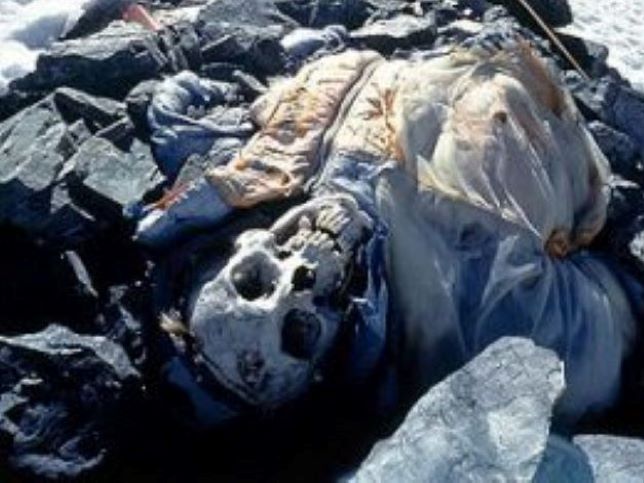
Everest is in the news again. As of late last week, 11 climbers had died this season on the storied mountain.
“Most of those deaths have been attributed to edema, exhaustion and hypothermia,” reads an AP article, “as well as to potential overcrowding on the mountain as the allure of Everest has led to more crowds and sometimes deadly delays.”
The article says that inexperienced hikers may have helped lead to the recent deadly episode, painting a grim and jumbled scene with “climbers faltering on the narrow passageway to the peak” and “climbers…crammed crampon-to-crampon along a sharp-edged ridge above South Col, with a 2,000-meter drop on either side, all clipped onto a single line of rope, trudging toward the top of the world and risking death as each minute ticked by.” One Indian climber narrowly escaped death on the mountain and lost two members of her expedition. She explained to a reporter that some of “the inexperienced climbers do not even know how to tie on the oxygen masks around their face.”
Apparently, all you need to climb the world’s tallest mountain is about $50,000—to cover the $11,000 permit from the Nepalese government and the cost of a touring agency—and a doctor’s note.
Still, at least some of those who died appeared to have been fairly veteran climbers. Utahan Don Cash, for example, “had 102 pairs of shoes,” “was a joker,” and “after losing three fingers from frostbite on a previous climb wore fake digits on a chain around his neck as a ‘conversation piece,’” according to an obituary about him in the Salt Lake Tribune. Summiting Everest would have enabled him to join the elusive “7 Summits Club,” a group reserved for climbers who have climbed the highest mountain on all seven of earth’s continents—the list includes Mount Denali in North America, Aconcagua in South America, Mont Blanc in Europe, Vinson Massif in Antarctica, Kilimanjaro in Africa, and Mount Kosciuszko in Australia. In fact, Cash made the list, just moments before his death he summited Everest.
But then he collapsed. Cash was given CPR and massages by his two Sherpa guides and was able to get back up, only to fall again on his way down an infamous passage called the Hillary Step. “He took his last breath,” the Tribune obituary reported. “His body was left there.” At a service last week in Salt Lake City his family repeatedly expressed joy that he was able to fulfill his climbing dreams and goals. “He would want me to tell you that his death was not a tragedy,” his wife Monette announced at the service at The Church of Jesus Christ of Latter-day Saints. “What is tragic is an unlived life. And he really believed that.”
Another one of the recent Everest deaths was a Colorado attorney named Christopher Kulish. He also died immediately after joining the elite climbing group reserved for people who have summited the highest peak on every continent. “He saw his last sunrise from the highest peak on Earth,” his brother Mark said in a news release. “At that instant, he became a member of the ‘7 Summit Club.’” He added, “He was an inveterate climber of peaks in Colorado, the West and the world over. He passed away doing what he loved.” His body, like the body of Don Cash, was left at the summit. “The conditions are so intense at such times that when a person dies, no one can afford to expend energy on carrying the body down from the mountain,” notes the AP article.
As the news stories about the recent Everest deaths point out, deaths on Everest are hardly new. In 2015, a magnitude 7.8 earthquake struck Nepal, killing a number of people on the mountain and helping bump that year’s death tally to 25. In 2014, 17 people were lost, most of the Sherpas killed in an avalanche. As Digital Dying writer Molly Gorny pointed out in an article published in 2015 about these events, Sherpa deaths tend not to get as much attention as the deaths of Western climbers. “There has always been a divide between Sherpas and Western summit-seekers, but these tensions have increased in recent years as Everest has become more accessible to unskilled-but-well-heeled climbers,” she wrote. “For the Sherpas, Everest has become increasingly more dangerous.” Her article notes that there are more than 200 corpses on Everest, they “remain in the exact position where the climber died.”
Digital Dying first wrote about deaths on Mount Everest in 2011, when we discussed an infamous website featuring photos of the Everest dead: “[The] website…shows a body from 1996 in a red parka, purple snow pants, and fluorescent green boots, in the lee of a rock wall with powdery snow drifted across his torso. Such a landmark is this body that it has been given a nickname, green boots. Another man lies half buried in a scree pile, with his climbing ropes still across his shoulders and his clothing ripped open across his back, revealing his pale white skin to the elements. One body is nothing but a skeleton in a sherbet-colored parka, with the head cocked to the side and the teeth intact. It seems to be grinning.”
But at the funeral for Don Cash, one of the eleven people who died climbing Mount Everest this year, the tone was much more upbeat. At one point during the ceremony, his daughter Danielle read the final entry in Cash’s journal, dated the day before he left for Nepal. “Today, I am grateful for my family,” the entry reads. “Just in case this is my last gratitude entry because something bad happened on Everest, I want everyone to know how much I love my wife, my kids and all my family and friends. I lived a great life. God blessed me. I have no regrets. I will see you all soon.”









